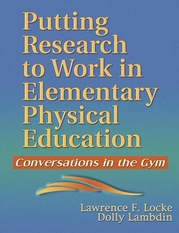MEDIA
REVIEW
Designed for practitioners and researchers, this book attempts
to show how ideas found in research can help to improve practice.
The book takes the novel approach of presenting the contrasting
perspectives of the two authors; Locke a noted researcher,
and Lambdin an experienced practitioner. Each author attempts
to draw practical implications for elementary physical education
from 30 previously published studies.
The book is organized into 10 parts; each addresses issues
that the authors believe have impacted upon the effectiveness
of elementary physical education teaching. Within these parts,
topics include the effect of class size and equipment on learning;
classroom management techniques; teaching strategies; children's
perspectives of the physical education experience; physical
education teachers perspectives of teaching; assessment; the
long-term impact of physical education on children's lives,
and more.
Although the authors attempt to present a concise summary
of often ponderous research details, it is their personal
reflections and practical implications that readers will find
most interesting. Often these implications confirm already
widely held beliefs about the challenges currently facing
elementary children's physical education. Similar to the conclusions
of the original research authors themselves, readers may be
left readily agreeing about what needs to be done, yet feeling
at a loss as to a course of action likely to have significant
impact.
At the conclusion of the book Locke and Lambdin urge readers
to devise their own action plans for improving elementary
physical education, emphasizing that change depends on our
actions - our personal willingness to make things happen.
They emphasize that the uniqueness of each teaching environment
demands that practitioners have to decide for themselves what
ideas will work for them.
In view of the resistance to change demonstrated by generations
of university trained physical education teachers, cynics
might question whether additional encouragement to reflect
could possibly have any impact. And yet change is occurring.
We continue to see positive examples that give us hope for
physical education's future. The advice of this book is to
stay motivated and recognize that we are individually capable
and indeed personally responsible for changing elementary
physical education.
Locke and Lambdin's book is not a quick read. It does not
- like so many of today's publications - offer quick fixes
or 50 ways to do something faster and better. It is a book
best read in small doses with time taken to reflect on current
practices. For teacher educators, readings in this book confirm
many of the principles already a part of undergraduate professional
preparation. For physical educators in professional preparation
or currently teaching who want to improve, this book offers
valuable insights into the characteristics of effective teaching
strategies and quality physical education programs. The book
would also be an excellent supplementary text for a graduate
level pedagogy class.
Reading this book reminded me of comments made by others,
who in summarizing the history of research in physical education
concluded that despite a vast amount of study so little has
changed in practice. In comparison to the world of science,
technology, and medicine, physical education today is little
different than it was 20 years ago. It is perhaps timely that
Locke and Lambdin have taken this step to force reflection
on some of our research. We can only hope that it will inspire
today's researchers to reflect upon the lack of practical
impact of too many studies destined to end up in unread thesis
and dissertations, or marginal research journals.
Locke and Lambdin should be commended for their efforts to
discuss and reflect upon the practical implications of scholarly
research. Many of us anticipate, with interest perhaps, a
forthcoming companion text that addresses issues in middle
and high school physical education.
To Main MEDIA
Review Page
(back
to pelinks4u homepage) |




